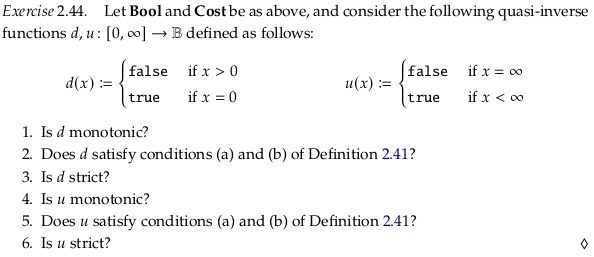Exercise 2.44#

To show \(d\) is a monotone map, we must show \(x ≥_{Cost} y\) implies \(d(x) ≤_B d(y)\) for all \(x,y \in B\). There are only nine cases to check, if we treat all numbers between 0 and \(\infty\) as one of three options for each variable:
\[\begin{split}
\begin{align} \\
0 \geq 0 & \to T \leq T \\
0 \geq 7 & \to T \leq F \\
0 \geq ∞ & \to T \leq F \\
7 \geq 0 & \to F \leq T \\
7 \geq 7 & \to F \leq F \\
7 \geq ∞ & \to F \leq F \\
∞ \geq 0 & \to F \leq T \\
∞ \geq 7 & \to F \leq F \\
∞ \geq ∞ & \to F \leq F \\
\end{align}
\end{split}\]
Checking condition (a) of Definition 2.41:
\[
T \leq d(0) = T
\]
Checking condition (b) of Definition 2.41:
\[\begin{split}
\begin{align} \\
d(0) \wedge d(0) = T & \to d(0 + 0) = T \\
d(0) \wedge d(7) = F & \to d(0 + 7) = F \\
d(0) \wedge d(∞) = F & \to d(0 + ∞) = F \\
d(7) \wedge d(0) = F & \to d(7 + 0) = F \\
d(7) \wedge d(7) = F & \to d(7 + 7) = F \\
d(7) \wedge d(∞) = F & \to d(7 + ∞) = F \\
d(∞) \wedge d(0) = F & \to d(∞ + 0) = F \\
d(∞) \wedge d(7) = F & \to d(∞ + 7) = F \\
d(∞) \wedge d(∞) = F & \to d(∞ + ∞) = F \\
\end{align}
\end{split}\]
Yes, \(d\) is a strict monoidal monotone.
To show \(u\) is a monotone map, we must show \(x ≥_{Cost} y\) implies \(u(x) ≤_B u(y)\) for all \(x,y \in B\). There are only nine cases to check, if we treat all numbers between 0 and \(\infty\) as one of three options for each variable:
\[\begin{split}
\begin{align} \\
0 \geq 0 & \to T \leq T \\
0 \geq 7 & \to T \leq T \\
0 \geq ∞ & \to T \leq F \\
7 \geq 0 & \to T \leq T \\
7 \geq 7 & \to T \leq T \\
7 \geq ∞ & \to T \leq T \\
∞ \geq 0 & \to F \leq T \\
∞ \geq 7 & \to F \leq T \\
∞ \geq ∞ & \to F \leq F \\
\end{align}
\end{split}\]
Checking condition (a) of Definition 2.41:
\[
T \leq u(0) = T
\]
Checking condition (b) of Definition 2.41:
\[\begin{split}
\begin{align} \\
u(0) \wedge u(0) = T & \to u(0 + 0) = T \\
u(0) \wedge u(7) = T & \to u(0 + 7) = T \\
u(0) \wedge u(∞) = F & \to u(0 + ∞) = F \\
u(7) \wedge u(0) = T & \to u(7 + 0) = T \\
u(7) \wedge u(7) = T & \to u(7 + 7) = T \\
u(7) \wedge u(∞) = F & \to u(7 + ∞) = F \\
u(∞) \wedge u(0) = F & \to u(∞ + 0) = F \\
u(∞) \wedge u(7) = F & \to u(∞ + 7) = F \\
u(∞) \wedge u(∞) = F & \to u(∞ + ∞) = F \\
\end{align}
\end{split}\]
Yes, \(u\) is a strict monoidal monotone.